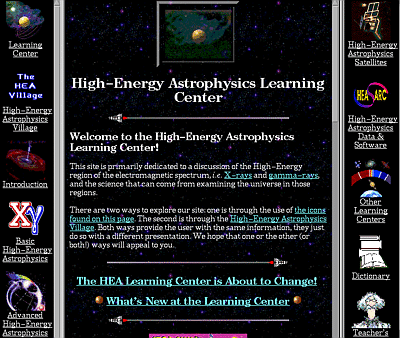Since its inception, one of NASA's mandates is to disseminate the results of its programs to the general public. Because of people's inherent interest in astronomy and spaceflight, NASA has been particularly successful in this outreach endeavor. Programs in gamma-ray astronomy are making a significant contribution to NASA's goals of education and to raising the level of public understanding and appreciation of science and technology. As our knowledge of the high-energy sky increases, so does our ability to communicate the promise and excitement of gamma-ray astronomy. The mystery of gamma-ray bursts, direct measurement of ongoing galactic nucleosynthesis, and observations of exotic objects such as black holes are examples of fields to which gamma-ray astronomy contributes.

Figure 7.1 - This cover image of a CD cersion of the high-energy Astrophysics Learning Center represents on of the many outreach efforts which are making gamma-ray astronomy results accessible to the general public.
Public information flourishes as a result of the many discoveries and new mysteries that have accompanied the growth of gamma-ray astrophysics in the last five years. This includes public talks by leading scientists at museums and planetariums around the country and front page articles in newspapers and magazines. More concerted efforts at public outreach activities in the CGRO era alone include posters and brochures put together by the CGRO Science Support Center and other organizations as well as numerous World Wide Web pages created by groups and individuals on specialized topics. A well-received exhibition at the Smithsonian Air and Space Museum is another example. Continuing this legacy of public outreach should be an important component of the gamma-ray astronomy programs in the future. Gamma-ray astronomy has touched education in a number of ways. Special grants to use the success of CGRO for educational purposes under the IDEAS program, from elementary to high schools, to college undergraduate and graduate education have also been highly successful. In addition, efforts such as the HEASARC's Learning Center page are beginning to present gamma-ray astronomy resources to younger students using the Internet. We encourage the use of add-on grants for educational purposes as an effective way to help active researchers contribute to science education.